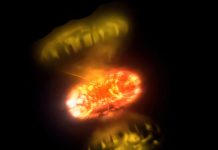
In a groundbreaking study using NASA’s James Webb Space Telescope (JWST), astronomers from Penn State and an international team have investigated the brightest gamma-ray burst ever detected, known as GRB 221009A or the “BOAT” (brightest of all time).
This celestial event, first observed in October 2022, originated from a massive star’s collapse and explosion, billions of light-years away.
The research, detailed in Nature Astronomy, delves into whether such explosions could be the cosmic furnaces where heavy elements like platinum and gold are forged.
These elements, heavier than iron, cannot be created through ordinary star processes and have mysterious origins.
Despite high hopes, the study revealed that this particular burst did not show signs of these heavy elements.
This suggests that even the most powerful explosions, like the BOAT, might not be responsible for creating these elements.
However, the team highlighted that this doesn’t rule out other gamma-ray bursts as potential sources.
Gamma-ray bursts (GRBs) like the BOAT are intense explosions that result in a bright afterglow of gamma rays and other particles.
The BOAT’s afterglow was so luminous that it initially hid any signs of a supernova explosion that typically follows such bursts.
Only months later, as the afterglow faded, could the researchers use JWST to confirm the presence of a supernova, although it turned out to be surprisingly ordinary despite the burst’s extraordinary brightness.
In their analysis, the researchers used JWST’s Near Infrared Spectrograph to examine the light from the supernova in infrared wavelengths. This method is ideal for spotting various elements, as each emits light uniquely when excited.
While they confirmed typical elements like calcium and oxygen, the anticipated heavy elements were absent.
The star’s dramatic finale took place in a galaxy with very low metallicity—the lowest among previously studied GRB host galaxies.
This unusual environment, marked by modest star formation and unique hydrogen patterns, may explain why such a record-breaking burst resulted from what appears to be nearly primordial conditions.
The lack of heavy elements in the BOAT’s aftermath raises more questions about where these crucial components of the universe are produced.
It underscores the significance of continuing cosmic investigations, with hopes that JWST may soon uncover other high-energy events that could finally reveal these secrets.
This study not only sheds light on the nature of the most luminous observed gamma-ray burst but also on the ongoing mystery of heavy element creation in the universe.
As research progresses, each discovery brings astronomers closer to understanding the extreme and energetic processes that shape our cosmos.
Source: UCLA.



